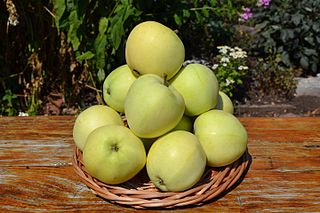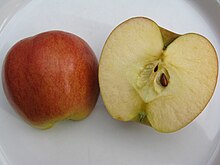
Malus is a genus of about 32–57 species of small deciduous trees or shrubs in the family Rosaceae, including the domesticated orchard apple, crab apples and wild apples.

Cider apples are a group of apple cultivars grown for their use in the production of cider. Cider apples are distinguished from "cookers" and "eaters", or dessert apples, by their bitterness or dryness of flavour, qualities which make the fruit unpalatable but can be useful in cidermaking. Some apples are considered to occupy more than one category.

The Haralson is a cultivar of apple that is medium-sized and has a round-conic shape.

The Flower of Kent is a green cultivar of cooking apple. According to the story, this is the apple Isaac Newton saw falling to ground from its tree, inspiring his laws of universal gravitation. It is pear-shaped, mealy, and sub-acid, and of generally poor quality by today's standards. As its name suggests, this cultivar likely originated from Kent, England.
A rootstock is part of a plant, often an underground part, from which new above-ground growth can be produced. It could also be described as a stem with a well developed root system, to which a bud from another plant is grafted. It can refer to a rhizome or underground stem. In grafting, it refers to a plant, sometimes just a stump, which already has an established, healthy root system, onto which a cutting or a bud from another plant is grafted. In some cases, such as vines of grapes and other berries, cuttings may be used for rootstocks, the roots being established in nursery conditions before planting them out. The plant part grafted onto the rootstock is usually called the scion. The scion is the plant that has the properties that propagator desires above ground, including the photosynthetic activity and the fruit or decorative properties. The rootstock is selected for its interaction with the soil, providing the roots and the stem to support the new plant, obtaining the necessary soil water and minerals, and resisting the relevant pests and diseases. After a few weeks, the tissues of the two parts will have grown together, eventually forming a single plant. After some years, it may be difficult to detect the site of the graft although the product always contains the components of two genetically different plants.

Honeycrisp is an apple cultivar developed at the Minnesota Agricultural Experiment Station's Horticultural Research Center at the University of Minnesota, Twin Cities. Designated in 1974 with the MN 1711 test designation, patented in 1988, and released in 1991, the Honeycrisp, once slated to be discarded, has rapidly become a prized commercial commodity, as its sweetness, firmness, and tartness make it an ideal apple for eating raw. "...The apple wasn't bred to grow, store or ship well. It was bred for taste: crisp, with balanced sweetness and acidity." It has larger cells than most apple cultivars, a trait which is correlated with juiciness, as theoretically a higher number of cells rupture when bitten, releasing more juice in the mouth. The Honeycrisp also retains its pigment well and has a relatively long shelf life when stored in cool, dry conditions. Pepin Heights Orchards delivered the first Honeycrisp apples to grocery stores in 1997. The name Honeycrisp was trademarked by the University of Minnesota, but university officials were unsure of its protection status in 2007. It is now the official state fruit of Minnesota. A large-sized honeycrisp will contain about 113 calories.

Esopus Spitzenburg or Aesopus Spitzenburgh is a variety of apple. It was discovered early in the 18th century near Esopus, Hudson, New York and is reputed to have been a favorite apple of Thomas Jefferson, who planted several of the trees at Monticello.

A pearmain, also formerly spelled "permain", is a type of apple. The name may once have been applied to a particular variety of apple that kept well, although in more modern times its inclusion in varietal names was, like the term 'Pippin', "largely decoration" rather than indicating any shared qualities.

The 'Spartan' is an apple cultivar developed by R. C Palmer and introduced in 1936 from the Federal Agriculture Research Station in Summerland, British Columbia, now known as the Pacific Agri-Food Research Centre - Summerland. The 'Spartan' is notable for being the first new breed of apple produced from a formal scientific breeding program. The apple was supposed to be a cross between two North American cultivars, the 'McIntosh' and the 'Newtown Pippin', but recently, genetic analysis showed the 'Newtown Pippin' was not one of the parents and its identity remains a mystery. The 'Spartan' apple is considered a good all-purpose apple. The apple is of medium size and has a bright-red blush, but can have background patches of greens and yellows.

Ashmead's Kernel is a triploid cultivar of apple. Traditionally, Ashmead's Kernel was thought to be diploid but a poor pollinator.

The Kingston Black, also known as Black Taunton, is a cultivar of apple originating from the United Kingdom and used in making cider. The name of the cultivar comes from the apples' dark red or purplish skin, though despite the name, the fruit does not have a black hue.

An apple is a round, edible fruit produced by an apple tree. Apple trees are cultivated worldwide and are the most widely grown species in the genus Malus. The tree originated in Central Asia, where its wild ancestor, Malus sieversii, is still found. Apples have been grown for thousands of years in Asia and Europe and were introduced to North America by European colonists. Apples have religious and mythological significance in many cultures, including Norse, Greek, and European Christian tradition.
'Brown Snout' is a 19th-century cultivar of cider apple originating in Herefordshire in the United Kingdom, though now grown in other counties and parts of the world.

The Foxwhelp is a very old cider apple cultivar, originating in the west Midlands of England.

The Styre or Stire, also known as the Forest Styre, was an old English variety of cider apple which was formerly common in the Forest of Dean. It is currently thought to be extinct, but may still survive in old orchards or gardens.

Papirovka is a cold-resistant early-ripening apple cultivar grown across Central and Eastern Europe and the Baltics. Along with Antonovka and others, it is one of five cultivars that comprise half of the apple production in the former USSR, and is one of the most popular early-summer varieties in Poland. It is prone to bruising, so it needs careful handling and storage.

'Clivia' is a German apple cultivar. It was created at the Institut für Acker- und Pflanzenbau of Müncheberg, in Märkisch-Oderland in eastern Germany, which at that time was in the German Democratic Republic. It is a hybrid of 'Geheimrat Dr. Oldenburg' and 'Cox's Orange Pippin'. It was reported as a new variety in 1964 and 1965; it was parent of a new cultivar, 'Pinova', in 1965.

Flamenco, also known as Ballerina Obelisk, is a cultivar of domesticated apple that bears apples good for eating fresh, and is grown for its unusual ornamental properties. The tree grows in a straight up columnar style, with many small fruit-bearing branches. 'Flamenco' is one of a series of apple tree cultivars that share a registered trademark under the name Ballerina.
The Pacific Agri-Food Research Centre is an agricultural research centre in British Columbia, Canada. The centre has been historically important in the development of tree fruits. It is administered by Agriculture and Agri-Food Canada and includes sites at Summerland and Agassiz.
















